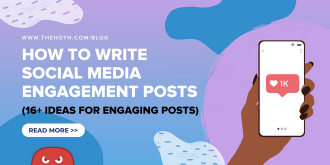Quick Links
If you often feel like there’s nothing new under the moon, you might be right. And it might actually be a good thing.
Instead of struggling to come up with new ideas, you can share existing content assets from other sources. Use someone else’s expertise and creative potential to draw attention to your brand — that’s what curated content is for.
Yes, you can curate content without running the risk of making a competing brand the star of the show. Let’s find out how to do that and what kinds of tools you’ll need.
What Is the Difference Between Created and Curated Content?
Firstly, let’s compare these two types of content side by side to spot the main differences.
Original content is tough to produce, while curation-worthy content is difficult to discover. However, you can minimize your efforts without sacrificing the quality of the content that you share — you just need to use content research tools (more on them in the following sections).
As you may have noticed, curated content also requires some fact-checking. But here’s a good rule of thumb: high-quality articles and reports usually already contain all the necessary links and citations, so going through them won’t take much of your time.
If the content piece that you’ve discovered doesn’t have any links, think twice before reposting it because it might contain outdated or inaccurate information.
7 Reasons Why You Should Be Using Curated Content
Successful marketers allocate at least 30% of their marketing budget to content creation. More companies are embracing long-form video content. 86% of consumers say that they prefer authentic, authoritative content, but 57% point out that brands aren’t doing enough in that direction.
Chances are, you’re bombarded with similar stats. Of course, they ring true, but not every company has a huge in-house content creation team to tick all the boxes.
What if you’re a small-business owner or a solo entrepreneur? What if you don’t have that kind of money or energy to spend on video content production, eBook editing, and podcast recording?
Having to create unique, fresh, and valuable content weekly can be exhausting, especially if you have another full-time job. It’s also costly — you’ll need to invest in gear and professional editing software, work with a presentation coach, and so on.
With content curation, you don’t need to worry about any of that. And sharing someone else’s content has many other advantages, too.
By linking to other experts in your industry, you show that you recognize their authority, pay attention to what they have to say, and don’t shy away from healthy competition. Also, that demonstrates that you care about your audience and want to provide them with the latest facts and insights.
Content curation allows you to try out new content formats and see what your subscribers react to. It’s also great to use for the times when you don’t have anything exciting to post about but want to keep your audience engaged.
Now that you have enough reasons to make room for carefully selected content in your content map, let’s talk practice.
How To Curate Content Without Drawing Attention Away From Your Brand
A typical content curation strategy includes five steps.
- Look for high-quality publications on social media platforms and expert blogs
- Sift through them to find the most relevant content pieces
- Share them on your resource
- Add your own commentary
- Link to the source to help your subscribers find the full version
Reposting someone else’s publications does sound risky, especially when you’re just starting to build your own social media presence. To retain your readership while sharing content, you need to follow these ground rules.
- Do thorough research and find reliable content sources on a scale (avoid your direct competitors). Create your own collection of thought leaders and companies who succeed at social media content creation and blogging, and go back to that list whenever you need new pieces of content.
- Use curated articles, reports, studies, podcasts, or interviews from different sources. It’ll help you make your content strategy more diverse and avoid focusing too much on a single indirect competitor.
- Avoid boring reposting. Create lists, collections, and in-depth stories out of already existing content pieces and turn them into your own assets as well.
- Use small chunks of curated content to strengthen your own brand voice. Add expert quotes, stats, takeaways, or even Twitter threads to illustrate your point.
- Schedule your curated content in advance. Doing that allows you to fill potential gaps in your strategy and spread curated posts more evenly across your feed or blog.
- Share projects and initiatives that you support. Help your partners get more exposure by showcasing their content on your channels.
- Add a personal touch to the content pieces you’re curating. Express your own opinion and add it as a comment to make curated content pieces align with your tone of voice and brand personality.
- Tag the author, thank them for their work, and encourage them to link to your resources as well. This gesture of appreciation will help you get more backlinks in the future because the authors of the content that you’re reposting might find value in your publications as well.
10 Curated Content Examples
Twitter is a fantastic platform for understanding how curated content works and what you should be sharing with your audience. You can see what industry moguls are sharing with their subscribers and how their audience is reacting.
Here are some ideas that you can also apply to your website, blog, or any other platform that you use.
#1. Surprise your audience
Share mind-blowing facts, shocking stats, or bold ideas with your audience to spark their curiosity and make them stop scrolling. You don’t have to be too formal about it, either. In fact, a brief but catchy comment would be way more useful here.
Don’t forget to link to the original source and express your appreciation of their work. In this example, using URL shorteners makes it easier to tag a few sources in a single tweet.
#2. Inspire your subscribers
It’s not enough to just find an interesting piece of content and repost it, saying, “here’s the link.” You need to motivate your audience to click on that link and pay genuine attention to the content that you’ve picked.
Visuals can be extremely helpful — you can even add custom images to the content that you’re sharing to make it a bit more on-brand without stealing the spotlight completely.
#3. Give your followers some food for thought
Use curated content to share your opinion on emerging trends or global events and spark discussions with your audience. Just make sure that you’re expressing your company’s true beliefs and not just jumping on the bandwagon — 56% of consumers say that too many brands are using societal issues just to attract conscious customers and boost sales.
If you do want to comment on some hot-button topics, double-check your sources to make sure that you aren’t spreading misinformation or presenting a one-sided view. Even though it’s someone else’s content, posting it on behalf of your brand may hurt your reputation.
#4. Make it personal
When curating content, always explain why you’ve decided to share this exact piece and how it can be useful to your audience. Reference your own previous or upcoming publications to build a more coherent conversation with your followers.
Although curated content isn’t about your brand, you can draw connections between it and your own blog posts or email newsletters. It’ll also help your new subscribers discover your social media accounts or other resources related to your business.
#5. Tie curated content to your own product
Use content curation to show how your customers can make the most of your offer. Reading about someone else’s experience with your product or service will help your potential buyers make the right choice.
This type of content also works as social proof since your audience can see how other experts or opinion leaders successfully interact with you or your company and achieve their goals.
#6. Collaborate
You can also curate content created by the brands or opinion leaders you’re partnering with. It will give your reputation a boost because your audience will see that your business has real influence and can be trusted.
This is a great way to feature someone else’s content without drawing attention away from your brand. Collaborations can positively influence the image of your brand and attract a new audience.
#7. Share customer success stories
Curated content can also include user-generated content (UGC) featuring your products or services or mentioning your brand in any other positive way. Customer success stories can inspire other users and increase their loyalty to and interest in your brand.
If you’re sharing a long-form article, make sure to add a brief summary to explain what it’s about and why your followers should read it.
#8. Share content from like-minded creators
Use content curation to show that your brand encourages creativity and is on the lookout for new collaborations and partnerships with creators who share the same values. This type of curated content can also help your audience discover new faces and names in the industry.
If you already have a sizable audience on social media, encourage your subscribers to share their work and get featured on your channels. In that case, you won’t even have to curate content yourself — it’s a win-win situation.
#9. Share expert advice
In some areas, you may not be fully equipped to give your followers expert tips, but it doesn’t mean that you have to stick to generic publications. Share helpful articles written by accomplished professionals, doctors, and practitioners to boost your brand trust.
This is a clever way to showcase your expertise without poaching on someone else’s territory. This type of curated content is especially relevant to skincare, supplement, and beauty brands that aren’t always authorized to speak from a scientific standpoint.
#10. Be playful
Take a break from being serious and share content that has something to do with your brand that you personally find amusing. In this example, we see how a fruit snack brand jokingly points out that one of Harry Styles’ songs is about their grape juice.
Funny curated content allows you to inject some novelty into your feed and makes your brand more humane, authentic, and approachable. In other words, that’s your key to “keeping it real.”
How To Curate Content Using Social Listening and Content Research Tools
Content creation doesn’t happen in a vacuum — first, you need to run a competitor analysis, see what’s currently trending, and which channels your target audience is using. Content curation also requires you to do similar research, although to a lesser extent.
The good news is that you can easily automate your content discovery process and focus on the most interesting part — selecting pure gems and adding them to your content plan.
Here’s how you can achieve that:
- Set up Google Alerts to monitor keywords, brand names, industry events, competitors, and so on.
- Use social listening tools like Mention, Awario, or Brand24 to get notified whenever someone publishes a new piece of content you would like to link to.
- Monitor Twitter trends to see what’s on everyone’s mind and what type of content you should be curating to cater to the needs of your audience.
- Use Google Trends to see trending searches at local and global levels.
How To Make Your Own Content Shareworthy
The main point of this post is that producing high-quality content at scale doesn’t have to be painful or overly complicated. If you don’t want to bore yourself with content research, try HOTH Blogger to cut every corner.
Here’s how it works. You reach out to us, and we find industry-specific keywords and topics for your business. Then, we match you with an expert blog writer who writes and formats the whole post for you. We offer unlimited edits and a 100% satisfaction guarantee to make sure that you get amazing content for your blog every time.





















